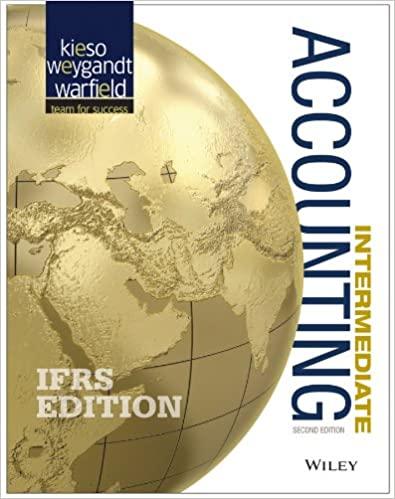Question
Sunland Corporation had a net income for the current year ending December 31, 2021 of $1,235,500. Throughout 2021 the following items were outstanding: 386,500 common
Sunland Corporation had a net income for the current year ending December 31, 2021 of $1,235,500. Throughout 2021 the following items were outstanding:
| 386,500 common shares | ||
| 19,500 Class A $3 cumulative preferred shares that were convertible to common shares at a rate of 1:1 | ||
| 52,000 Class B $4 non-cumulative preferred shares that were convertible at a rate of one common share for every two preferred shares. | ||
| $504,000, 8% bonds that were convertible to 14,000 common shares | ||
| $297,000, 10% bonds convertible to 12,000 common shares |
No dividends were declared or paid in 2021. Sunlands tax rate is 25%.
1.Calculate the income effect of the dividends on Class A preferred shares.
2.Calculate the income effect of the dividends on Class B preferred shares.
3.Calculate basic earnings per share. (For simplicity, ignore the requirement to record the debt and equity portions of the convertible bond separately). (Round answer to 2 decimal places, e.g. 15.25.)
4.Calculate the after-tax interest paid on the 8% bonds.
5.Determine an incremental per share effect for 8% bonds. (Round earnings per share to 2 decimal places, e.g. 15.25.)
| Potentially dilutive security | Incremental Numerator Effect | Incremental Denominator Effect | EPS | |||
| 8% Bonds | $ | $ |
6.Calculate the after-tax interest paid on the 10% bonds.
7.
Determine an incremental per share effect for 10% bonds. (Round earnings per share to 2 decimal places, e.g. 15.25.)
| Potentially dilutive security | Incremental Numerator Effect | Incremental Denominator Effect | EPS | |||
| 10% Bonds | $ | $ |
8.Determine an incremental per share effect for Class A preferred shares. (Round earnings per share to 2 decimal places, e.g. 15.25.)
| Potentially dilutive security | Incremental Numerator Effect | Incremental Denominator Effect | EPS | |||
| Class A preferred shares | $ | $ |
9.Determine an incremental per share effect for Class B preferred shares. (Round earnings per share to 2 decimal places, e.g. 15.25.)
| Potentially dilutive security | Incremental Numerator Effect | Incremental Denominator Effect | EPS | |||
| Class B Preferred shares | $ | $ |
10.Rank the potentially dilutive securities from most dilutive to least dilutive.
| 8% bonds | Rank 1Rank 2Rank 3Rank 4Anti-dilutive | |
| 10% bonds | Rank 1Rank 2Rank 3Rank 4Anti-dilutive | |
| Class A preferred shares | Rank 1Rank 2Rank 3Rank 4Anti-dilutive | |
| Class B preferred shares | Rank 1Rank 2Rank 3Rank 4Anti-dilutive |
11.Calculate diluted earnings per share. (Round calculations of EPS to 3 decimal places, e.g. $3.545 and provide final answer to 2 decimal places, e.g. 15.25.)
| Numerator | Denominator | EPS | |||||
| Basic | $ | $ | |||||
| Class A preferred sharesClass B preferred shares8% bonds10% bonds | |||||||
| Sub Total | |||||||
| Class A preferred sharesClass B preferred shares8% bonds10% bonds | |||||||
| Sub Total | |||||||
| Class A preferred sharesClass B preferred shares8% bonds10% bonds | |||||||
| $ | $ |
| Diluted EPS |

Step by Step Solution
There are 3 Steps involved in it
Step: 1

Get Instant Access to Expert-Tailored Solutions
See step-by-step solutions with expert insights and AI powered tools for academic success
Step: 2

Step: 3

Ace Your Homework with AI
Get the answers you need in no time with our AI-driven, step-by-step assistance
Get Started


